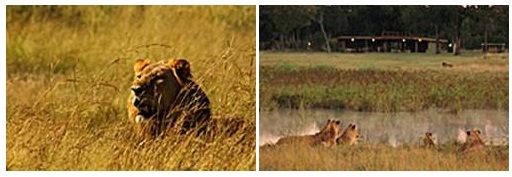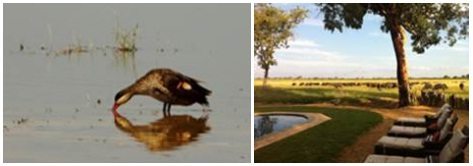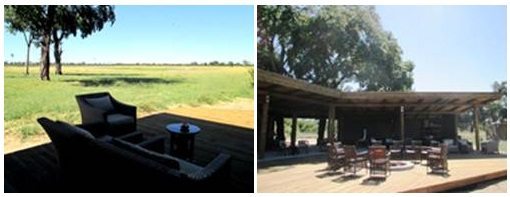Davison’s Camp – June 2014
Climate and Landscape
Not many of us can remember an April that was as green as this year in Hwange – the vegetation is still thick and only now do the grasslands have a hint of soft gold as the tops of the grasses dry out. There are still little bursts of colour with the dwindling wild flowers – Pretty Lady, Witch Weed and Blue Comelina to name a few. The waterhole in front of camp is still thick with reeds, home to a little family of white-faced ducks, a lone grey heron and some very noisy Egyptian geese. The tiny cream-green flowers of the false mopane have been pollinated and fat shiny bean-like pods have taken their place, while the velvet chocolate brown pods of the teak trees are already well on their way. The remaining natural waterholes and puddles are becoming muddy spas for a multitude of game, much to the indignation of the resident terrapins.
And just when we thought the rains had moved on, the crisp blue April skies clouded over and we had a number of late showers – 83 mm in total! With Hwange winters renowned for their chill, these surprise downpours cooled things down much quicker and much earlier and guests were delighted to find a hot water bottle in their beds in the evenings once they had torn themselves away from the fire. Midday temperatures were still pleasant, even reaching 30 Celsius at the beginning and end of April, which meant sarongs and shorts by the pool during the hottest time of the day, and then beanies and scarves as night-time temperatures dipped as low as 10 Celsius. One evening while guests were still on their night drive back into camp, they saw the most incredible shooting star, a large pale green light falling to the south with a trail of white sparks following it.
Wildlife
Despite the rains lingering and the thick flora, sightings this month have been unbelievable and the lions certainly have taken centre stage. There are a number of prides around and within the Wilderness Safaris concessions in Hwange, and all have been seen on numerous occasions.

The two young black-maned males who took over the pride usually seen at Linkwasha have been exceptionally vocal in and around camp. Wake-up calls were a matter of form, not necessity, quite a few times as these two made their presence heard, with deep roars before the sun had even peeped over the horizon. Their pride of 18 consists of about five beautiful females, some sub-adults and cubs along with two tiny additions. Often guides would pick up the flick of an ear or tail in a blue bush and spot one of the pride hidden away. Then, after stopping the vehicle and allowing guests’ eyes to become accustomed to the mottled light, the shapes of lion after lion would emerge.
There hasn’t been much evidence of successful hunts and we were all concerned about the cubs getting nourishment, until one evening when two guests and their guide were coming back into camp and they heard a commotion in the thick teak woodland they were driving through. They couldn’t see what was happening but the cracking and rustle of small bushes, the loud bellows of a buffalo and the low growls of the lions painted a pretty clear picture of what was taking place. The following day the lions arrived with very round stomachs to drink from the waterhole right in front of camp.
We had a succession of amazing wild dog experiences over three days in April too. When first spotted they were attempting to bring down a waterbuck but they were unsuccessful; however the following day they were seen again with full bellies and in a heap of snoozing bodies in the shade of a leadwood tree. The next day we couldn’t believe it when one of the housekeepers came from the staff rooms at the back of camp saying that the dogs had sprinted past him in hot pursuit of a kudu – everyone ran to see if they were still close by or if anything could be heard but there was only spoor left. We went back to the office only to be called by one of the waiters saying the dogs were in front of camp and had made a kill! Guests and staff were lucky to see the dogs tucking in and then some running off with scraps of meat to enjoy on their own, until finally all eight went to lie in the shallows of the pan to cool off as the day heated up.
Plains game has been abundant with a small dazzle of zebra making its home right in front of camp. Good herds of eland were seen a few times at Ngamo vlei and lovely sable sightings were recorded too – once a herd of over 20, including small brown calves. Herds of buffalo have also been seen frequently, their great charcoal shapes plodding out of the treeline towards the pans. The elephant are all looking very round and healthy, clearly still enjoying the abundance of food and water available. Some guests were lucky enough to have had sightings of roan and gemsbok, as well as the smaller crowd-pleasers like bat-eared foxes, dwarf mongoose and genet.
Wildlife percentages for April: lion 63%, eland 37%, elephant 97%, buffalo 80%, giraffe 73%, sable 17%, side-striped jackal 53%, leopard 7%
Birds and Birding
As it starts to cool off the summer migrants are all starting to move north, but the birdlife in and around camp is still fantastic. The saddle-billed storks and spoonbills are still wading through the pans, stirring up something to eat, while the teals, white-faced ducks and Egyptian geese leave little wakes as they paddle across the water. A juvenile African harrier-hawk has been loitering around camp and has been seen a few times with his talons and beak reaching down into holes and fissures in the trees in search of insects and reptiles hidden away.

Camp Activities
April started in a frenzy to complete the new main lounge and dining areas, as well as a new front deck and upstairs viewing platform. The varnish had just dried and the last wood chips swept away as our first guest arrived and it’s been all systems go since! We welcomed another new member to the team, professional guide Elliot Nobula, who has vast experience in this industry and we are very happy to have him on board.


